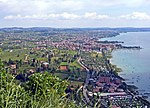Cavaion Veronese
Cities and towns in VenetoMunicipalities of the Province of VeronaVeneto geography stubs
Cavaion Veronese is a comune (municipality) in the Province of Verona in the Italian region Veneto, located about 120 kilometres (75 mi) west of Venice and about 20 kilometres (12 mi) northwest of Verona. As of 31 December 2004, it had a population of 4,459 and an area of 12.9 square kilometres (5.0 sq mi).The municipality of Cavaion Veronese contains the frazione (subdivision) Sega. Cavaion Veronese borders the following municipalities: Affi, Bardolino, Pastrengo, Rivoli Veronese, and Sant'Ambrogio di Valpolicella.
Excerpt from the Wikipedia article Cavaion Veronese (License: CC BY-SA 3.0, Authors).Cavaion Veronese
Via Cà Nove,
Geographical coordinates (GPS) Address Nearby Places Show on map
Geographical coordinates (GPS)
| Latitude | Longitude |
|---|---|
| N 45.533333333333 ° | E 10.766666666667 ° |
Address
Via Cà Nove
Via Cà Nove
37010
Veneto, Italy
Open on Google Maps









